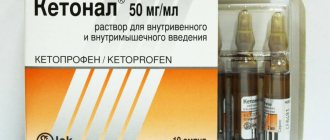Ketonal injections are a popular medication in the complex treatment of diseases of the musculoskeletal system. The medicine belongs to the group of non-steroidal anti-inflammatory drugs. The solution in ampoules is used for intramuscular and intravenous administration.
Composition and indications
The main active ingredient in the drug is ketoprofen. Ketonal ampoules contain 2 ml of solution with 100 mg of active substance. The injection liquid may be clear or have a slightly yellowish tint.
Ketoprofen has anti-inflammatory, analgesic and antipyretic properties. It is quickly absorbed from the gastrointestinal tract, which causes quick results.
Ketonal injections are indicated in the treatment of various diseases for the symptomatic treatment of disease processes. They are most effective for relieving pain that accompanies inflammatory and degenerative diseases of the musculoskeletal system.
Ketonal injections, the instructions for use confirm this, improve the condition of rheumatoid and seronegative arthritis during exacerbation of diseases when severe pain occurs.
For symptomatic treatment, the drug is also prescribed:
- For gout. With the development of this disease, uric acid salts are deposited in the joints, which causes their modification and severe pain. Ketonal injections are indicated to relieve an attack of gout, which is characterized by swelling in the area of one of the joints and pressing pain in it.
- For osteoarthritis. As a rule, the cause of the pathology is damage to the joint or an inflammatory process in it. Ketonal injections can relieve pain and maintain joint mobility.
Ketonal injections are prescribed to relieve post-traumatic and postoperative pain syndrome. Thanks to its pronounced analgesic properties, the drug improves the condition of cancer, algodisminorrhea, and inflammation of the pelvic organs. It can be used to relieve severe headaches caused by various reasons, as well as in other pathological conditions:
- Migraine.
- Myalgia.
- Bursitis.
- Radiculitis.
- Neuralgia.
Contraindications
A contraindication to ketonal injections is hypersensitivity to the active ingredient or other non-steroidal anti-inflammatory drugs, as well as salicylates.
It is prohibited to use ketonal injections in many other cases. All of them are indicated in the instructions for use of the drug. Injections with the drug are not prescribed until the age of 15 years, in the third trimester of pregnancy and during lactation.
Main contraindications of the drug:
- Exacerbation of peptic ulcer of the stomach and duodenum.
- Heart, liver and kidney failure.
- Blood clotting disorders.
You should stop using the drug if you are diagnosed with Crohn's disease and ulcerative colitis, or if you suspect gastrointestinal or other bleeding. Ketonal injections are not prescribed; the instructions warn about this after coronary artery bypass surgery.
Ketonal film-coated tablets 100 mg 20 pcs. in St. Petersburg
Ketoprofen should not be combined with other NSAIDs and/or COX2 inhibitors.
With long-term use of NSAIDs, it is necessary to periodically evaluate a clinical blood test, monitor kidney and liver function, especially in elderly patients (over 65 years), and conduct a stool test for occult blood.
It is necessary to be careful and monitor blood pressure more often when using ketoprofen to treat patients suffering from arterial hypertension and cardiovascular diseases that lead to fluid retention in the body.
If visual disturbances occur, treatment should be stopped immediately.
Like other NSAIDs, ketoprofen can mask the symptoms of infectious and inflammatory diseases. If you notice signs of infection or deterioration in health while using the drug, you should immediately consult a doctor.
If there is a history of contraindications from the gastrointestinal tract (bleeding, perforation, peptic ulcer), long-term therapy and the use of high doses of ketoprofen, the patient should be under close medical supervision.
Because of the important role of prostaglandins in maintaining renal blood flow, particular caution should be exercised when using ketoprofen in patients with cardiac or renal insufficiency, as well as in the treatment of elderly patients taking diuretics and patients who, for any reason, have a decrease in circulating volume. blood.
The drug should be discontinued before major surgery.
The use of ketoprofen can affect female fertility, therefore, patients with infertility (including those undergoing examination) are not recommended to use the drug.
Impact on the ability to drive vehicles and machinery
There is no data on the negative effect of the drug Ketonal® in recommended doses on the ability to drive a car or operate machinery. At the same time, patients who experience drowsiness, dizziness or other unpleasant sensations from the nervous system, including visual impairment, while using the drug, should refrain from driving vehicles and engaging in potentially hazardous activities that require increased concentration and speed of psychomotor reactions.
Use during pregnancy
According to studies, ketaprofen can have a negative effect on the general course of pregnancy and provoke spontaneous abortion. In addition, when taking the drug there is a risk of developing intrauterine pathologies of the fetus. At the same time, the likelihood of negative consequences for the mother and unborn child increases depending on the dose and duration of use of the drug.
Ketanol injections are prescribed in the first and second trimesters only in cases where the benefits to the woman outweigh the possible risks to the fetus. In this case, the minimum effective dose is indicated, which is taken in a short course.
Absolute contraindications to taking the drug in the third trimester are explained by the fact that ketanol injections can lead to the possible development of weakness of the uterus and other pathological conditions. In addition, even small doses of the drug during this period of pregnancy can increase the duration of bleeding and have a negative effect on the fetus. The use of ketanol injections during lactation is attributed to the fact that studies on whether ketaprofen gets into breast milk and its effect on the child have not been conducted.
Side effects and overdose
Ketonal injections, the instructions for use warn about this, can cause serious negative side reactions of the body from various systems of the human body. You should carefully read the manufacturer's warnings before using the product for symptomatic treatment.
The most common side effects are insomnia, depression, and asthenia. Nervous system disorders may be accompanied by headaches and increased weakness. Also, after taking the medicine, dyspeptic disorders often occur.
An overdose of ketoprofen poses a health risk. Higher doses may cause vomiting and abdominal pain. The drug, used once in large quantities, can lead to respiratory depression, convulsions, and loss of consciousness. There are risks of developing renal dysfunction. If an overdose is confirmed, you urgently need to rinse your stomach and take absorbents. Further symptomatic treatment is recommended.
Ketonal injections, which are affordable, interact with many other medications. Therefore, it is strictly forbidden to use them for self-medication. Dosages are prescribed by the doctor depending on the patient’s condition and in accordance with the recommendations of the instructions for use.
Ketonal forte tablets p/o 100 mg No. 20 No. 1
Name
Ketonal forte tablet coated. captivity. about 100 mg per bottle. No. 20 in pack No. 1
Description
Light blue, round, biconvex film-coated tablets.
Main active ingredient
Ketoprofen
Release form
Pills
Dosage
Keep out of the reach of children. Store at a temperature not exceeding 25°C. Store in original packaging.
pharmachologic effect
Pharmacodynamics
Ketoprofen, the active ingredient of the drug, inhibits the synthesis of prostaglandins and leukotrienes by blocking the enzyme cyclooxygenase (cyclooxygenase-1 (COX-1) and cyclooxygenase-2 (COX-2)), which catalyzes the synthesis of prostaglandins in the metabolism of arachidonic acid. Ketoprofen stabilizes lysosomal membranes in vitro and in vivo, in high concentrations inhibits the synthesis of leukotrienes in vitro and has anti-bradykinin activity in vivo. The mechanism of the antipyretic effect of ketoprofen is unknown. It is possible that ketoprofen inhibits the synthesis of prostaglandins in the central nervous system (most likely in the hypothalamus). In some women, ketoprofen reduces the symptoms of primary dysmenorrhea, probably by suppressing the synthesis and/or effectiveness of prostaglandins.
Pharmacokinetics
Ketoprofen is well absorbed from the gastrointestinal tract. After taking 100 mg of ketoprofen orally, its peak plasma concentration (10.4 mcg/ml) is reached in 1 hour 22 minutes. The bioavailability of ketoprofen after oral administration at a dose of 50 mg is 90% and increases linearly with increasing doses. Ketoprofen is a racemic mixture, but the pharmacokinetics of the two enantiomers are similar. 99% of ketoprofen binds to plasma proteins, mainly to the albumin fraction. The volume of distribution in tissues is 0.1-0.2 l/kg. Ketoprofen penetrates into the synovial fluid. Three hours after the administration of 100 mg of ketoprofen, its concentration in plasma is about 3 μg/ml, and the concentration in synovial fluid is 1.5 μg/ml. After nine hours, its concentration in plasma is about 0.3 μg/ml, and the concentration in synovial fluid is 0.8 μg/ml. This means that ketoprofen slowly penetrates into the synovial fluid and is also slowly eliminated from it, while its plasma concentration decreases further. If ketoprofen is taken with food, absorption slows down and plasma concentrations decrease slightly, but bioavailability remains the same. After oral administration of 50 mg ketoprofen with meals four times a day, a peak concentration of 3.9 μg/ml was achieved in 1.5 hours compared to 2.0 μg/ml after two hours when taking ketoprofen on an empty stomach. Equilibrium concentrations of ketoprofen are established 24 hours after its administration. In elderly patients, steady-state concentration was reached after 8.7 hours and was 6.3 mcg/ml. Ketoprofen is extensively metabolized by liver microsomal enzymes. It binds to glucuronic acid and is excreted in this form from the body. After oral administration, its plasma clearance is 1.16 ml/min/kg. Due to its rapid metabolism, its biological half-life is only two hours. Up to 80% of ketoprofen is excreted in the urine, mainly (over 90%) in the form of ketoprofen glucuronide, and about 10% is excreted in the feces. Special groups of patients With liver damage In patients with liver failure, probably due to hypoalbuminemia (free biologically active ketoprofen), the concentration of ketoprofen almost doubles, which requires the administration of a minimum daily dose that provides a sufficient therapeutic effect. With kidney damage In patients with renal failure, the clearance of ketoprofen is reduced. Therefore, in case of severe renal failure, a dose reduction is required.
Indications for use
Ketonal forte is a non-steroidal antirheumatic drug with anti-inflammatory, analgesic and antipyretic effects. It is used for pain relief in a range of pain syndromes and for the treatment of inflammatory, degenerative and metabolic rheumatic diseases. Indications for use: - rheumatoid arthritis; - ankylosing spondylitis; - acute gout; — osteoarthritis of various localizations; - lumbosacral radiculitis, radiculitis; - myalgia; - tendinitis, tendovaginitis, bursitis, synovitis, capsulitis; - bruises, ligament damage, dislocations; - sprains, muscle tears - phlebitis, superficial thrombophlebitis, lymphangitis; - painful inflammatory diseases in dentistry, otolaryngology, urology and pulmonology.
Directions for use and doses
For oral administration. Undesirable effects can be minimized by taking the drug at the lowest effective dose for the shortest possible time necessary to relieve symptoms. The usual dose is 1-2 tablets per day, between meals. The maximum daily dose of ketoprofen is 200 mg. Before starting treatment at a dose of 200 mg per day, the possible risks and benefits should be carefully weighed. The use of higher doses is not recommended (see also “Special instructions and precautions”). Elderly patients and patients with impaired renal function It is recommended to reduce the initial dose and prescribe maintenance therapy using the lowest effective dose. If the drug is well tolerated, dose adjustment can be considered on an individual basis. Patients with impaired liver function Such patients should be closely monitored and the drug should be used at the lowest effective daily dose. Children The safety and effectiveness of ketoprofen in children have not been studied.
Use during pregnancy and lactation
Inhibition of prostaglandin synthesis may have a negative effect on pregnancy and/or embryo/fetal development. In the first and second trimesters of pregnancy, the drug should not be prescribed unless absolutely necessary. If Ketonal Forte is used by a woman who is trying to become pregnant or who is in the first or second trimester of pregnancy, the dose should be as low as possible and the duration of treatment should be as short as possible. In the third trimester of pregnancy, the use of Ketonal forte is contraindicated. There are no data on the penetration of the drug into milk. It is not recommended to prescribe Ketonal forte to nursing mothers.
Precautionary measures
Avoid simultaneous use of the drug with NSAIDs, including selective COX-2 inhibitors. Older adults are more likely to experience adverse reactions to NSAIDs, especially gastrointestinal bleeding and perforation, which can be fatal (see Dosage and Administration). Gastrointestinal bleeding, ulceration, and perforation Gastrointestinal bleeding, ulceration, or perforation, which may be fatal, has been reported for all NSAIDs and may occur at any time during treatment, with or without preexisting symptoms or severe gastrointestinal disease. tract in the anamnesis. Taking Ketonal forte may be associated with a high risk of severe gastrointestinal toxicity, which is typical for some other NSAIDs, especially when taken in high doses (see also “Doses and route of administration” and “Contraindications”). The risk of gastrointestinal bleeding, ulceration or perforation increases with increasing doses of NSAIDs, in patients with a history of peptic ulcer disease, especially complicated by bleeding or perforation (see "Contraindications"), as well as in the elderly. Treatment of these patients should be started with the lowest dose available. For these patients, as well as for patients concomitantly taking low-dose acetylsalicylic acid or other drugs that increase the risk of gastrointestinal complications, combination therapy with protective drugs (eg, misoprostol or proton pump blockers) should be considered (see below and “Interaction with other medicinal products and other types of interactions”). Patients with a history of gastrointestinal toxicity, especially the elderly, should report any unusual abdominal symptoms (especially gastrointestinal bleeding), especially early in treatment. Particular caution should be exercised when co-administered with drugs that may increase the risk of ulceration or bleeding, such as oral corticosteroids, anticoagulants (eg, warfarin), selective serotonin reuptake inhibitors, or antiplatelet agents such as acetylsalicylic acid (see Interactions with other medications and other types of interactions"). If patients experience gastrointestinal bleeding or ulcers during treatment with Ketonal forte, the drug should be discontinued. NSAIDs should be prescribed with caution to patients with a history of gastrointestinal diseases (ulcerative colitis, Crohn's disease), since they may experience exacerbations of these diseases (see “Side Effects”). Cardiovascular and cerebrovascular effects. Patients with a history of hypertension and/or mild to moderate congestive heart failure require appropriate monitoring and counseling as fluid retention and edema have been reported with the use of NSAIDs. The use of some NSAIDs (especially at high doses and during long-term treatment) may be associated with an increased risk of arterial thrombosis (eg, myocardial infarction or stroke) (see Warnings and Precautions). There is insufficient data to exclude such a risk for ketoprofen. In patients with uncontrolled arterial hypertension, congestive heart failure, established diagnosis of coronary artery disease, peripheral arterial disease and/or cerebrovascular disease, treatment with Ketonal Forte should be carried out only after a careful assessment of benefits and risks. The same should be done before prescribing long-term treatment for patients with risk factors for cardiovascular disease (eg, hypertension, hyperlipidemia, diabetes mellitus, smoking). Patients suffering from bronchial asthma in combination with chronic rhinitis, chronic sinusitis and/or nasal polyposis are more likely to experience allergic reactions after taking acetylsalicylic acid and/or NSAIDs than other patients. Prescribing Ketonal forte may cause an attack of bronchial asthma or bronchospasm, especially in patients with an allergy to acetylsalicylic acid or NSAIDs (see “Contraindications”). In patients with heart failure, cirrhosis and nephrotic syndrome, as well as in patients taking diuretics and in patients with chronic renal failure, especially the elderly, renal function should be carefully monitored at the start of treatment. In such patients, the administration of Ketonal forte may cause a decrease in renal blood flow due to inhibition of prostaglandin synthesis and lead to decompensation of renal function. In patients with abnormal liver function tests or a history of liver disease, blood transaminase levels should be periodically monitored, especially during prolonged therapy. Rare cases of jaundice and hepatitis have been described in connection with the use of ketoprofen. Treatment should be discontinued if visual disturbances such as blurred vision occur. The drug is prescribed with caution to persons suffering from alcohol dependence. Severe skin reactions (some of them fatal) associated with the use of NSAIDs, such as exfoliative dermatitis, Stevens-Johnson syndrome and toxic epidermal necrolysis, have been reported extremely rarely (see “Side effects”). The greatest risk of developing these reactions is at the beginning of the course of treatment; in most cases, reactions occur in the first month of treatment. Ketonal forte should be discontinued at the first appearance of a skin rash, lesions on the mucous membranes or other signs of hypersensitivity. Ketonal forte can mask the signs and symptoms of infectious diseases, such as elevated body temperature. Before extensive surgical interventions, the drug must be discontinued. The use of Ketonal forte may reduce fertility, so it is not recommended for women planning pregnancy. In women experiencing difficulties in achieving pregnancy or being examined for infertility, discontinuation of Ketonal forte should be considered. Ketonal forte tablets contain lactose. Therefore, they should not be taken by patients with hereditary galactose intolerance, lactase deficiency or impaired absorption of glucose and galactose.
Interaction with other drugs
Drug combinations not recommended Other NSAIDs (including selective cyclooxygenase-2 inhibitors) and salicylates in high doses: increased risk of ulcers and bleeding in the gastrointestinal tract. Anticoagulants (heparin and warfarin) and platelet aggregation inhibitors (eg, ticlopidine, clopidogrel): increased risk of bleeding (see Warnings and Precautions). If co-administration is necessary, close medical supervision is required. Lithium: Risk of increased plasma lithium levels, which can sometimes reach toxic levels due to decreased renal excretion of lithium. If necessary, plasma lithium concentrations should be carefully monitored and the dose of lithium adjusted during and after NSAID treatment. Methotrexate in doses exceeding 15 mg/week: increased risk of hematotoxicity of methotrexate, especially if used in high doses (>15 mg/week), which is likely due to the displacement of methotrexate from protein binding and reduced renal clearance. Combinations Requiring Caution Diuretics: Patients receiving diuretics, especially those with dehydration, are at increased risk of renal failure due to decreased renal blood flow due to inhibition of prostaglandin synthesis. Such patients should be adequately hydrated before initiating concomitant use of these drugs, and renal function should be monitored at the start of treatment (see "Special Instructions and Precautions"). Angiotensin-converting enzyme (ACE) inhibitors and angiotensin II receptor antagonists. In patients with impaired renal function (eg, dehydrated patients or the elderly), concomitant use of an ACE inhibitor or angiotensin II receptor antagonist and cyclooxygenase inhibitors may cause further deterioration of renal function, including possible acute renal failure. Methotrexate in doses below 15 mg/week: in the first weeks of combination treatment, it is necessary to monitor the detailed blood picture once a week. If there is any impairment of renal function and in elderly patients, monitoring should be carried out more often. Corticosteroids: Increased risk of developing ulcers or bleeding in the gastrointestinal tract (see Warnings and Precautions). Pentoxifylline: increases the risk of bleeding. More frequent clinical monitoring and more frequent control of bleeding time are necessary. Combinations that need to be considered Antihypertensive drugs (beta blockers, ACE inhibitors, diuretics): ketoprofen reduces the effect of antihypertensive drugs (inhibition of the synthesis of vasodilator prostaglandins). Thrombolytics: increased risk of bleeding. Selective serotonin reuptake inhibitors: increased risk of gastrointestinal bleeding (see "Special Instructions and Precautions"). Probenecid: Concomitant use of probenecid may significantly reduce the plasma clearance of ketoprofen. Combinations that should also be taken into account: Cyclosporine, tacrolimus: risk of additive nephrotoxicity, especially in elderly patients.
Contraindications
- Hypersensitivity to ketoprofen or any of the excipients of the drug; - a history of rhinitis, bronchospasm, bronchial asthma, urticaria or allergic reactions after using ketoprofen or similar active substances, such as other nonsteroidal anti-inflammatory drugs (NSAIDs) or salicylates (eg, acetylsalicylic acid); in such patients, severe (in rare cases fatal) anaphylactic reactions have been described (see “Side effects”); - severe heart failure; — treatment of pain in the perioperative period during coronary artery bypass grafting (CABG); - history of chronic dyspepsia; - peptic ulcer in the acute phase, as well as a history of gastrointestinal bleeding, ulcer or perforation; - predisposition to bleeding; - severe renal dysfunction; - severe liver dysfunction; - last trimester of pregnancy (see “Pregnancy and lactation”); - children.
Compound
Each tablet contains 100 mg of ketoprofen. Excipients Tablet core: magnesium stearate, colloidal anhydrous silicon dioxide, povidone, corn starch, purified talc, lactose monohydrate. Tablet shell: hypromellose E464, macrogol 400, blue indigotine dye E132, titanium dioxide E171, purified talc, carnauba wax.
Overdose
Cases of overdose of ketoprofen in a dose of up to 2.5 g have been described. In most cases, the observed symptoms were benign in nature and were limited to lethargy, drowsiness, nausea, vomiting and epigastric pain. There is no special antidote for an overdose of ketoprofen. If a significant overdose is suspected, gastric lavage and symptomatic and supportive therapy are recommended to eliminate dehydration. You also need to monitor diuresis and correct acidosis (if it develops). If renal failure develops, hemodialysis may be effective to remove the drug circulating in the blood.
Side effect
Edema, high blood pressure and heart failure have been reported in association with treatment with non-selective NSAIDs. If severe side effects occur, treatment should be discontinued. Adverse effects are distributed by organ system class, by frequency of occurrence and descending severity: very common (≥ 1/10); frequent (≥ 1/100,
Storage conditions
Keep out of the reach of children. Store at a temperature not exceeding 25°C. Store in original packaging.
Buy Ketonal forte tablet coated. captivity. about 100 mg per bottle. No. 20 in pack No. 1 in the pharmacy
Price for Ketonal forte tablet coated. captivity. about 100 mg per bottle. No. 20 in pack No. 1
Instructions for use for Ketonal forte tablet coating. captivity. about 100 mg per bottle. No. 20 in pack No. 1




